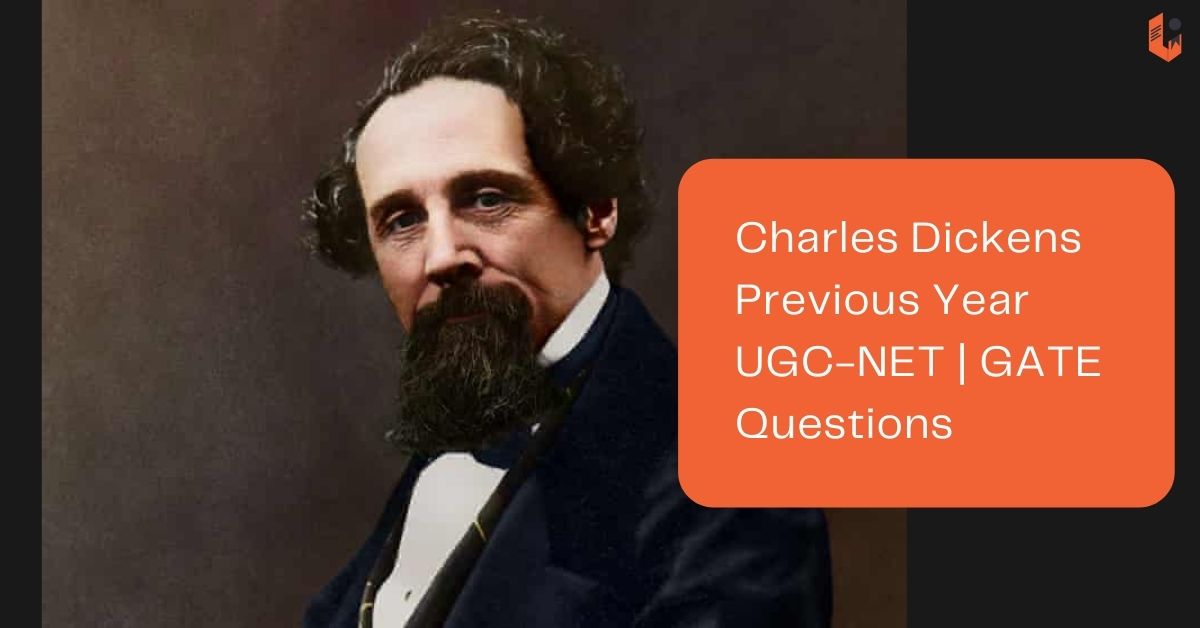UPDATE: Now, you can get these 3000+ questions in booklet/hardcopy format. Click here to know more.
Match the imaginary location with its creator :
1. Emily Bronte
2. Thomas Hardy
3. Lowood Parsonage
4. Charles Dickens
5. Wessex
6. Egdon Heath
7. Coketown
8. Charlotte Bronte
(A) 1-7 2-5 4-6 3-8
(B) 1-6 2-5 3-8 4-7
(C) 1-5 2-6 3-8 4-7
(D) 2-5 1-7 3-4 6-8
Ans: (B)
What is “Forster Collection” ?
(A) Memorabilia and documents related to the Scottish War of Independence (1296-1328) housed in Glasgow Museum
(B) The special collection of E. M. Forster effects housed in King’s College, Cambridge
(C) The largest collection of Charles Dickens manuscripts and proofs curated by John Forster
(D) The collection of political and military documents named after the liberal M. P., W. E. Forster reputed for the Forster Education Act
Ans: (C)
Read the following statement and the reason given for it. Choose the right response.
Assertion(A) : Dickens’s novels are called ‘Newgate Novels’.
Reason (R) : They are called so, because Dickens adulates in these novels the careers and adventures of criminals.
(A) Both (A) and (R) are true and(R) is the correct explanation.
(B) Both (A) and (R) are true, but (R) is not the correct explanation.
(C) (A) is true, but (R) is false.
(D) (A) is false, but (R) is true.
Ans: (A)
Put the following novels by Charles Dickens in a sequential order with the help of the code :
1. Great Expectations
2. Hard Times
3. Bleak House
4. A Tale of Two Cities
Code :
(A) 3, 2, 4, 1
(B) 2, 4, 3, 1
(C) 1, 2, 4, 3
(D) 4, 2, 1, 3
Ans: (A)
Which character in Dickens keeps on hoping that “something will turn up”?
(A) Barkis
(B) Micawber
(C) Uriah Heep
(D) Miss Havisham
Ans: (B)
Who among the following authors were greatly influenced by Thomas Carlyle’s writings?
I. Charles Dickens
II. Elizabeth Gaskell
III. Emily Bronte
IV. Oscar Wilde
The right combination according to the code is
(A) I and II
(B) II and III
(C) I and IV
(D) I and III
Ans: (A)
Match the columns :
Character Novel
I. Lady Dedlock
II. Lady Bertram
III. Lady Harriet
IV. Lady Jane
1. Vanity Fair
2. Wives and Daughters
3. Mansfield Park
4. Bleak House
I II III IV
(A) 4 2 3 1
(B) 3 2 1 4
(C) 4 3 2 1
(D) 3 4 1 2
Ans: (C)
Listed below are the titles of novels and the sources to which they are aligned by readers.
Match them appropriately :
1. Daniel Defoe’s Robinson Crusoe
2. Charlotte Bronte’s Jane Eyre
3. R.M. Ballantyne’s The Coral Island
4. Charles Dickens’s Great Expectations
I. Peter Carey’s Jack Maggs
II. J.M. Coetzee’s Foe
III. Jean Rhys’s Wide Sargasso Sea
IV. William Golding’s Lord of the Flies
I II III IV
(A) 4 1 3 2
(B) 4 3 1 2
(C) 4 1 2 3
(D) 4 2 1 3
Ans: (C)
Chapter III of Oliver Twist opens with a narratorial remark about Oliver being punished for “the commission of the impious and profane offence of asking for more.” What did Oliver ask for more ?
(A) More time to play
(B) More food to eat
(C) More books to read
(D) More money to spend
Ans: (B)
Peter Ackroyd’s first novel, The Great Fire of London, picks up the historical echoes and artfully deploys a Dickens novel as an intertext. Identify the source Dickens text.
(A) Great Expectations
(B) Little Dorrit
(C) Martin Chuzzlewit
(D) Old Curiosity Shop
Ans: (B)
The Office of Circumlocution occurs in :
(A) Little Dorrit
(B) Bleak House
(C) Great Expectations
(D) Hard Times
Ans: (A)
Which of the following is not true of the novels of Charles Dickens?
(A) They deal with the problems of the discontents of an urban civilization.
(B) The plots are strikingly tight-knit.
(C) They share a sense of fun and determining optimism.
(D) They incorporate elements of popular contemporary culture.
Ans: (B)
Charles Dickens opined that “no man ever before had the art of making himself mentally so like a woman since the world began.” He was acknowledging the quality of the work of which writer?
(A) Walter Scott
(B) William Mackpeace Thackeray
(C) George Meredith
(D) George Eliot
Ans: (D)
Arrange the following in the chronological order of publication :
(A) In Memoriam -A Christmas Carol -Men and Women -Henry Esmond
(B) A Christmas Carol -In Memoriam -Men and Women -Henry Esmond
(C) A Christmas Carol -In Memoriam -Henry Esmond -Men and Women
(D) In Memoriam -A Christmas Carol -Henry Esmond -Men and Women
Ans: (C)
The Tale of Two Cities has :
(A) a sentimental buffoon with a moral purpose
(B) a courageous lady in pain
(C) an optimist on verge of collapse
(D) a romantic hero with a weakness
Ans: (B)
Charles Dickens’s A Tale of Two Cities begins with the sentence
(A) It was the best of times; it was the worst of times.
(B) It was the brightest of times; it was the darkest of times.
(C) It was the richest of times; it was the poorest of times.
(D) It was the happiest of times; it was the saddest of times.
Ans: (A)
The Court of Chancery is a setting in Dickens’
(A) Little Dorrit
(B) Hard Times
(C) Dombey and Son
(D) Bleak House
Ans: (D)
Little Nell is a character in Dickens’s
(A) Hard Times
(B) Great Expectations
(C) Oliver Twist
(D) The Old Curiosity Shop
Ans: (D)
Put the following novels by Charles Dickens in a sequential order with the help of the code :
1. Great Expectations
2. Hard Times
3. Bleak House
4. A Tale of Two Cities
Code :
(A) 3, 2, 4, 1
(B) 2, 4, 3, 1
(C) 1, 2, 4, 3
(D) 4, 2, 1, 3
Ans: (A)
Charles Dickens caricatured utilitarian thinking with telling directness in his portrayal of
(A) Paul Dombey
(B) Thomas Gradgrind
(C) Philip Pirrip
(D) Harold Skimpole
Ans: (B)
Literary works such as Charles Dickens’s David Copperfield, Samuel Butler’s The Way of All Flesh and James Joyce’s A Portrait of the Artist as a Young Man provide examples of which following novelistic form?
(A) Nouveau roman or new novel
(B) Epistolary novel
(C) Bildugsroman
(D) Historical novel
Ans: (C)
Little Nell is a character in Dickens’
(A) David Copperfield
(B) The Old Curiosity Shop
(C) Bleak House
(D) Great Expectations
Ans: (B)
Charles Dickens’s visit to the United States produced _________.
(A) Hard Times
(B) Nicholas Nickleby
(C) Martin Chuzzlewit
(D) Oliver Twist
Ans: (C)
Lady Dedlock is a character in Dickens’s
(A) Bleak House
(B) Great Expectations
(C) David Copperfield
(D) Hard Times
Ans: (A)
Charles Dickens’s Bleak House is pointedly critical of England’s :
(A) Privy Council
(B) Court of Appeal
(C) Court of Chancery
(D) military courts
Ans: (C)
Which novels opens thus:
“Whether I shall turn out to be the hero of my own life, or whether that station will be held by anyone else, these pages must show.”
(A) Tristram Shandy
(B) Lady Audley’s Secret
(C) David Copperfield
(D) Fitz-Boodle’s Confessions
Ans: (C)
Identify the character, a black-eyed dwarf who “constantly revealed a few discoloured fangs that were yet scattered in his mouth, and gave him the aspect of a panting dog”.
(A) Mulberry Hawk in Nicholas Nickleby
(B) Rigand in Little Dorrit
(C) Mr. Crook in Bleak House
(D) Daniel Quilp in The Old Curiosity Shop
Ans: (D)
Nicholas Nickleby firmly established Charles Dickens as a dominant novelist of his time and the book as an unrivalled literacy phenomenon. To celebrate the completion of the book, a painter noted that there had been nothing comparable to him since the days of Samuel Richardson. Identify the painter.
(A) Leonard Woolf
(B) David Wilkie
(C) John Cruickshank
(D) Ernest Dawson
Ans: (B)
Considering the story of the novel, what does the title Dombey and Son stand for?
(A) It suggests the choice between a son and a daughter
(B) It suggests the commercial aspect of life
(C) It suggests the opposition between a father and a son
(D) It suggests the importance of a dynasty
Ans: (A)
Match the character with the novel :
Character Novel
(a) Kate
(b) Florence
(c) Miss Havisham
(d) Agnes
(i) Great Expectations
(ii) Nicholas Nickleby
(iii) David Copperfield
(iv) Dombey and Son
Choose the correct option from those given below :
(A) (a)-(i); (b)-(iii); (c)-(iv); (d)-(ii)
(B) (a)-(ii); (b)-(iv); (c)-(i); (d)-(iii)
(C) (a)- (iii); (b)-(i); (c)-(ii); (d)-(iv)
(D) (a-iv); (b)-(ii); (c)-(iii); (d)-(i)
Ans: (B)
Which of the following fictional characters is in the right Chronological order?
(A) Uncle Toby- Man Friday- Stephen Dedalus- Miss Havisham
(B) Stephen Dedalus- Man Friday – Uncle Toby- Miss Havisham
(C) Man Friday- Uncle Toby- Miss Havisham –Stephen Dedalus
(D) Miss Havisham- Uncle Toby- Stephen Dedalus- Man Friday
Ans: (C)
Which of the following set of characters in Charles Dickens’ novels is in the right chronological order?
(A) Bounderby – David Copperfield- Mrs. Mann- Nathaniel Winkle
(B) David Copperfield- Mr. Bounderby- Nathaniel Winkle- Mrs. Mann
(C) Nathaniel winkle- Mrs. Mann- David Copperfield- Mr. Bounderby
(D) Mann- David Copperfield- Nathaniel winkle- Mr. Bounderby
Ans: (C)
Harold Skimpole is a character in:
(A) Bleak House
(B) Dombey and Son
(C) Great Expectations
(D) Oliver Twist
Ans: (A)


